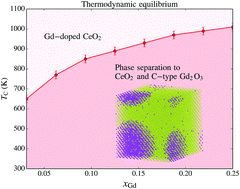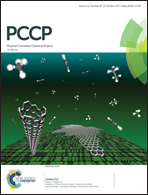Ordering and phase separation in Gd-doped ceria: a combined DFT, cluster expansion and Monte Carlo study†
Abstract
Ordering of dopants and oxygen vacancies is studied for Gd-doped ceria (xGd ≤ 0.25) by means of a combined density functional theory (DFT) and cluster expansion approach, where the cluster interactions derived from DFT calculations are further used in Monte Carlo simulations. The methodology is meticulously tested and the stability of the obtained solutions with respect to the volume change, applied exchange–correlation approximation and other modelling parameters is carefully analysed. We study Gd and vacancy ordering in the case of thermodynamic equilibrium and vacancy ordering for quenched Gd configurations. We find that at the thermodynamic equilibrium there exists a transition temperature (TC) below which phase separation into C-type Gd2O3 and pure CeO2 occurs. The phase separation is observed in the whole studied concentration range and the transition temperature increases with concentration from ca. 600 (xGd = 0.03) to 1000 K (xGd = 0.25). Above TC the distribution of Gd is random, oxygen vacancies tend to cluster in the coordination shells along 〈1, 1/2, 0〉 and 〈1, 1, 1〉, and the nearest neighbour position is preferred for Gd-vacancy. In the quenched Gd case, where Gd atoms are immobilised below 1500 K, the vacancy ordering is significantly frustrated. In fact, we observe an oxygen freezing transition below temperature TF ≈ TC − 350 K, which is close to temperatures at which a change in the conductivity slope is observed experimentally.

- This article is part of the themed collection: 2017 PCCP HOT Articles


 Please wait while we load your content...
Please wait while we load your content...